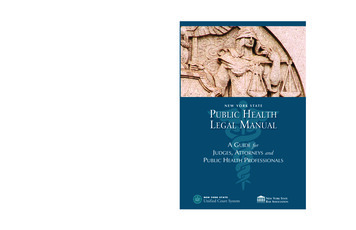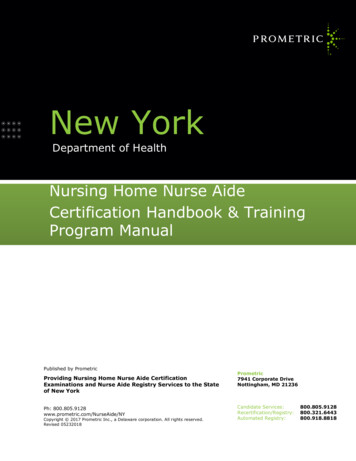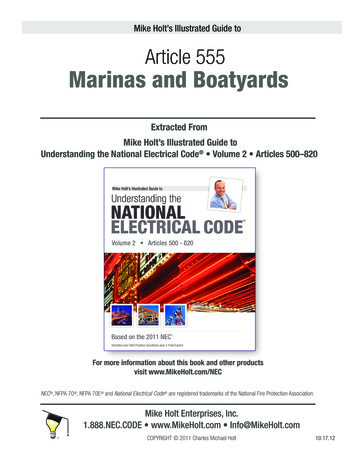
Transcription
NEW YORK STATEMULTIPLE DWELLING LAWARTICLE 1INTRODUCTORY PROVISIONS; DEFINITIONS§1. Short title. This chapter shall be known as the "multiple dwelling law."§2. Legislative finding. It is hereby declared that intensive occupation of multiple dwelling sites,overcrowding of multiple dwelling rooms, inadequate provision for light and air, and insufficientprotection against the defective provision for escape from fire, and improper sanitation ofmultiple dwellings in certain areas of the state are a menace to the health, safety, morals, welfare,and reasonable comfort of the citizens of the state; and that the establishment and maintenance ofproper housing standards requiring sufficient light, air, sanitation and protection from firehazards are essential to the public welfare. Therefore the provisions hereinafter prescribed areenacted and their necessity in the public interest is hereby declared as a matter of legislativedetermination.§3. Application to cities, towns and villages.1. This chapter shall apply to all cities with a population of three hundred twenty-five thousandor more.2. The legislative body of any other city, town or village may adopt the provisions of thischapter and make the same applicable to dwellings within the limits of such city, town orvillage by the passage of a local law or ordinance adopting the same; and upon the passage ofsuch local law or ordinance all of the provisions of articles one, two, three, four, five, ten andeleven and such sections or parts of sections of the other articles of this chapter as such locallaw or ordinance shall enumerate, shall apply to such city, town or village from the datestated in such law or ordinance.3. Except as herein otherwise specified, every multiple dwelling shall be constructed ormaintained in conformity with other applicable laws.4.a. Any city, town or village may make local laws, ordinances, resolutions or regulations notless restrictive than those provided in this chapter and may provide for their enforcementby legal or equitable actions or proceedings, and prescribe the penalties, sanctions andremedies for violations thereof. In the enforcement and administration of this chapter in acity of three hundred twenty-five thousand or more persons, the penalties, sanctions andremedies enacted by local law may be applied, notwithstanding their inconsistency withthis chapter, or the provisions of this chapter.b. In a city of three hundred twenty-five thousand or more persons, such local laws mayauthorize such actions or proceedings against the owner, lessee of a whole multipledwelling, agent or other person having control of such dwelling, and any responsibleparty, or against the dwelling in rem. Such local laws may further authorize(1) that civil penalties may be enforced against the person liable therefor, and that inaddition to the methods of enforcement for judgments established in the civil practicelaw and rules, a lien may be imposed against the premises and the rents therefrom;(2) that such civil penalties may be enforced against the dwelling by the imposition of alien against the rents therefrom.
NEW YORK STATEMULTIPLE DWELLING LAWc. Such local laws may also authorize that all liens upon rents, whether authorized by stateor local law, may be satisfied without further judicial proceedings by the collection ofrents due or to become due.5. Whenever a provision of any local law, ordinance, resolution or regulation is more restrictivein a requirement for height, area or use, such local law, ordinance, resolution or regulationshall govern and take precedence over any lesser requirements of this chapter. When,however, the provisions of this chapter impose more restrictive requirements, the provisionsof this chapter shall govern.6. A local law, ordinance, resolution or regulation shall not prohibit in any class A multipledwelling erected after April eighteenth, nineteen hundred twenty-nine, in compliance withthe provisions of this chapter, the use of wood for sleepers, grounds, nailing blocks,underflooring or finish flooring or, within apartments, doors with their assemblies, interiortrim and assemblies of exterior windows, interior finish, closet fixtures, kitchen fixtures,shelving, cupboards, cabinets or wardrobes.7. Except as provided in subdivisions four and five, a local law, ordinance, rule or regulationshall not modify or dispense with any provision of this chapter.8. Wherever the word "city" occurs in this chapter, it shall be construed as though followed bythe words "or town or village to which this chapter is applicable." The words "charter,""ordinance," "resolution," "regulation," "building code," "department of health," "departmentof water supply," "fire department," "department," "board," "city engineer," "corporationcounsel," "city treasury," or "fire limits," shall be construed as if followed by the words "orcorresponding authority of any city, town or village to which this chapter is applicable and inwhich the dwelling or location referred to is situated."9. Wherever in any statute of the state other than this chapter, or in any local law, ordinance,resolution or regulation, reference is made to the tenement house law in relation to a city towhich this chapter is applicable, such reference shall be construed as applying to theprovisions of this chapter. If reference be made therein to any section or other part of thetenement house law, such reference shall be construed as applying to the provisions of thischapter relating to the same subject matter as the said section or part. If reference be madetherein to a "tenement house," such reference shall be construed as applying to a class Amultiple dwelling.10. Wherever the date April eighteenth, nineteen hundred twenty-nine, shall appear in thischapter such date shall be construed as if followed by the words "or the date when thischapter or any of its provisions became or becomes applicable to any city, town or villageoutside the City of New York."11. Notwithstanding any other provision of this section, the following enumerated articles,sections and subdivisions of sections of this chapter shall not apply to the construction oralteration of multiple dwellings for which an application for a permit is made to thedepartment after December sixth, nineteen hundred sixty-nine in a city having a populationof one million or more which adopts or has adopted local laws, ordinances, resolutions orregulations providing protection from fire hazards and making provision for escape from firein the construction and alteration of multiple dwellings and in other respects as protective aslocal law seventy-six of the laws of the city of New York for nineteen hundred sixty-eightand covering the same subject matter as the following: subdivisions twenty-five, twentyseven, twenty-eight, thirty-five-c, thirty-six and thirty-nine of section four, subdivision threeof section twenty-eight, sections thirty-six, thirty-seven, fifty, fifty-one, fifty-two, fifty-three,
NEW YORK STATEMULTIPLE DWELLING LAWfifty-five, sixty, sixty-one, sixty-seven, subdivisions one, two, four and five of sectionseventy-five, article four, article five, article five-A, article six and article seven-B; exceptthat after December sixth, nineteen hundred sixty-nine where a multiple dwelling erectedprior to December sixth, nineteen hundred sixty-nine is altered, or a building erected prior toDecember sixth, nineteen hundred sixty-nine is converted to a multiple dwelling pursuant toa permit applied for to the department having jurisdiction, the foregoing articles, sections andsubdivisions of sections shall remain applicable where a local law of such city authorizessuch alteration or conversion to be made, at the option of the owner, either in accordancewith the requirements of the building law and regulations in effect in such city prior toDecember sixth, nineteen hundred sixty-eight or the requirements of the building law andregulations in effect after such date, and the owner elects to comply with the requirements ofthe building law and regulations in effect prior to December sixth, nineteen hundred sixtyeight.§4. Definitions. Certain words and terms when used in this chapter, unless the context or subjectmatter requires otherwise, are defined as follows:1. Wherever the word or words "occupied," "is occupied," "used" or "is used" appear, suchword or words shall be construed as if followed by the words "or is intended, arranged ordesigned to be used or occupied."2. The word "shall" is always mandatory.3. The term "department" shall mean the department, bureau, division or other agency chargedwith the enforcement of this chapter.4. A "dwelling" is any building or structure or portion thereof which is occupied in whole or inpart as the home, residence or sleeping place of one or more human beings.5. A "family" is either a person occupying a dwelling and maintaining a household, with notmore than four boarders, roomers or lodgers, or two or more persons occupying a dwelling,living together and maintaining a common household, with not more than four boarders,roomers or lodgers. A "boarder," "roomer" or "lodger" residing with a family shall mean aperson living within the household who pays a consideration for such residence and does notoccupy such space within the household as an incident of employment therein.6. A "private dwelling" is any building or structure designed and occupied exclusively forresidence purposes by not more than two families. A building designed for and occupiedexclusively by one family is a "single-family private dwelling." A building designed for andoccupied exclusively by two families is a "two-family private dwelling." Private dwellingsshall also be deemed to include a series of one-family or two-family dwelling units each ofwhich faces or is accessible to a legal street or public thoroughfare provided that each suchdwelling unit is equipped as a separate dwelling unit with all essential services, and alsoprovided that each such unit is arranged so that it may be approved as a legal one-family ortwo-family dwelling.7. A "multiple dwelling" is a dwelling which is either rented, leased, let or hired out, to beoccupied, or is occupied as the residence or home of three or more families livingindependently of each other. On and after July first, nineteen hundred fifty-five, a "multipledwelling" shall also include residential quarters for members or personnel of any hospitalstaff which are not located in any building used primarily for hospital use provided, however,that any building which was erected, altered or converted prior to July first, nineteen hundredfifty-five, to be occupied by such members or personnel or is so occupied on such date shall
NEW YORK STATEMULTIPLE DWELLING LAWnot be subject to the requirements of this chapter only so long as it continues to be sooccupied provided there are local laws applicable to such building and such building is incompliance with such local laws. A "multiple dwelling" shall not be deemed to include ahospital, convent, monastery, asylum or public institution, or a fireproof building usedwholly for commercial purposes except for not more than one janitor's apartment and notmore than one penthouse occupied by not more than two families. For the purposes of thischapter "multiple dwellings" are divided into two classes: "class A" and "class B."8.a. A "class A" multiple dwelling is a multiple dwelling that is occupied for permanentresidence purposes. This class shall include tenements, flat houses, maisonetteapartments, apartment houses, apartment hotels, bachelor apartments, studio apartments,duplex apartments, kitchenette apartments, garden-type maisonette dwelling projects, andall other multiple dwellings except class B multiple dwellings. A class A multipledwelling shall only be used for permanent residence purposes. For the purposes of thisdefinition, "permanent residence purposes" shall consist of occupancy of a dwelling unitby the same natural person or family for thirty consecutive days or more and a person orfamily so occupying a dwelling unit shall be referred to herein as the permanentoccupants of such dwelling unit. The following uses of a dwelling unit by the permanentoccupants thereof shall not be deemed to be inconsistent with the occupancy of suchdwelling unit for permanent residence purposes:(1)(A) occupancy of such dwelling unit for fewer than thirty consecutive days by othernatural persons living within the household of the permanent occupant such ashouse guests or lawful boarders, roomers or lodgers; or(B) incidental and occasional occupancy of such dwelling unit for fewer than thirtyconsecutive days by other natural persons when the permanent occupants aretemporarily absent for personal reasons such as vacation or medical treatment,provided that there is no monetary compensation paid to the permanent occupantsfor such occupancy.(2) In a class A multiple dwelling owned by an accredited not-for-profit college oruniversity or leased by such a college or university under a net lease for a term offorty-nine years or more, the use of designated dwelling units for occupancy for fewerthan thirty consecutive days shall not be inconsistent with the occupancy of suchmultiple dwelling for permanent residence purposes if:(A) No more than five percent of the dwelling units in such multiple dwelling but notless than one dwelling unit, are designated for such use and the designation of aunit once made may not be changed to another unit;(B) A list of the designated dwelling units certified by an authorized representative ofthe college or university is kept on the premises by the owner or net lessee andmade available upon request for inspection by the department or the firedepartment of such city;(C) Only designated dwelling units on the certified list are used for occupancy forfewer than thirty consecutive days and only by(i) natural persons, other than persons whose only relationship with the college oruniversity is as a student, for whom the college or university has undertaken toprovide housing accommodations such as visiting professors and academics,
NEW YORK STATEMULTIPLE DWELLING LAWgraduate students with research or teaching fellowships, researchers andpersons presenting academic papers, interviewing for positions ofemployment or having other similar business with the college or university, or(ii) natural persons for whom a hospital affiliated with such college or universityhas undertaken to provide housing accommodations such as patients, patients'families and/or accompanying escorts, medical professionals and healthcareconsultants or persons having other similar business with such hospital. A logshall be maintained on the premises of the names and addresses of suchpersons and the duration and reason for their stay. Such log shall be accessibleupon request for inspection by the department and the fire department of suchmunicipality;(D) No rent or other payment is collected for such occupancy; and(E) The fire department of such city shall require the filing of a fire safety plan orother appropriate fire safety procedure.b. A "garden-type maisonette dwelling project" is a series of attached, detached or semidetached dwelling units which are provided as a group collectively with all essentialservices such as, but not limited to, water supply and house sewers, and which units arelocated on a site or plot not less than twenty thousand square feet in area under commonownership and erected under plans filed with the department on or after April eighteenth,nineteen hundred fifty-four, and which units together and in their aggregate are arrangedor designed to provide three or more apartments.9. A "class B" multiple dwelling is a multiple dwelling which is occupied, as a rule transiently,as the more or less temporary abode of individuals or families who are lodged with orwithout meals. This class shall include hotels, lodging houses, rooming houses, boardinghouses, boarding schools, furnished room houses, lodgings, club houses, college and schooldormitories and dwellings designed as private dwellings but occupied by one or two familieswith five or more transient boarders, roomers or lodgers in one household.10. A "converted dwelling" is a dwelling(a) erected before April eighteenth, nineteen hundred twenty-nine, to be occupied by one ortwo families living independently of each other and subsequently occupied as a multipledwelling, or(b) a dwelling three stories or less in height erected after April eighteenth, nineteen hundredtwenty-nine, to be occupied by one or two families living independently of each otherand subsequently occupied by not more than three families in all, with a maximumoccupancy of two families on each floor in a two story building and one family on eachfloor in a three story building, in compliance with the provisions of article six of thischapter, including section one hundred seventy-a of said article. A converted dwellingoccupied as a class A multiple dwelling is a class A converted dwelling; every otherconverted dwelling is a class B converted dwelling.11. A "tenement" is any building or structure or any portion thereof, erected before Aprileighteenth, nineteen hundred twenty-nine, which is occupied, wholly or in part, as theresidence of three families or more living independently of each other and doing theircooking upon the premises, and includes apartment houses, flat houses and all other housesso erected and occupied, except that a tenement shall not be deemed to include any converteddwelling. An "old-law tenement" is a tenement existing before April twelfth, nineteen
NEW YORK STATEMULTIPLE DWELLING LAWhundred one, and recorded as such in the department before April eighteenth, nineteenhundred twenty-nine, except that it shall not be deemed to include any converted dwelling.12. A "hotel" is an inn having thirty or more sleeping rooms.13. A "rooming house" or a "furnished room house" is a multiple dwelling, other than a hotel,having less than thirty sleeping rooms and in which persons either individually or as familiesare housed for hire or otherwise with or without meals. An inn with less than thirty sleepingrooms is a rooming house.14. A "lodging house" is a multiple dwelling, other than a hotel, a rooming house or a furnishedroom house, in which persons are housed for hire for a single night, or for less than a week atone time, or any part of which is let for any person to sleep in for any term less than a week.15. An "apartment" is that part of a multiple dwelling consisting of one or more roomscontaining at least one bathroom and arranged to be occupied by the members of a family,which room or rooms are separated and set apart from all other rooms within a multipledwelling.16. "Single room occupancy" is the occupancy by one or two persons of a single room, or of twoor more rooms which are joined together, separated from all other rooms within an apartmentin a multiple dwelling, so that the occupant or occupants thereof reside separately andindependently of the other occupant or occupants of the same apartment. When a class Amultiple dwelling is used wholly or in part for single room occupancy, it remains a class Amultiple dwelling.17. A "public hall" is a hall, corridor or passageway within a building but outside of allapartments and suites of private rooms. A "public vestibule" is a corridor, not within anapartment or suite of private rooms, providing access to a stair or elevator and not wider thanseven feet nor longer than twice the width of the stair or elevator shafts opening upon it. A"public room" or "public part" of a dwelling is a space used in common by the occupants oftwo or more apartments or rooms, or by persons who are not tenants, or exclusively formechanical equipment of such dwelling or for storage purposes.18. A "living room" is a room which is not a public hall, public vestibule, public room or otherpublic part of a dwelling. Every room used for sleeping purposes shall be deemed a livingroom. Dining bays and dinettes fifty-five square feet or less in floor area, foyers, water-closetcompartments, bathrooms, cooking spaces less than eighty square feet in area, and halls,corridors and passageways entirely within an apartment or suite of rooms shall not bedeemed living rooms. "Floor space" shall mean the clear area of the floor contained withinthe partitions or walls enclosing any room, space, foyer, hall or passageways of any dwelling.19. A "dining bay," "dining recess" or "dinette" is a recess used for dining purposes off a livingroom, foyer or kitchen.20. A "foyer" is a space within an apartment or suite of rooms used as an entrance hall directlyfrom a public hall.21. A "dormitory" in a lodging house is any place used for sleeping purposes. A "cubicle" is asmall partially enclosed sleeping space within a dormitory with or without a window to theouter air.22. "Premises" shall mean land and improvements or appurtenances or any part thereof.23. "Structure" shall mean a building or construction of any kind.24. "Alteration," as applied to a building or structure, shall mean any change or rearrangement inthe structural parts or in the egress facilities of any such building or structure, or any
NEW YORK STATEMULTIPLE DWELLING LAWenlargement thereof, whether by extension on any side or by any increase in height, or themoving of such building or structure from one location or position to another.25. A "fireproof multiple dwelling" is one in which the walls and other structural members are ofincombustible materials or assemblies meeting all of the requirements of the building codeand with standard fire-resistive ratings of not less than one of the following sets ofrequirements:a. For any multiple dwelling more than one hundred feet in height, four hours for fire walls,party walls, piers, columns, interior structural members which carry walls, girderscarrying columns, and for exterior walls other than panel walls; three hours for othergirders, fire partitions, floors including their beams and girders, beams, roofs, floorfillings, and stairway enclosures; and two hours for exterior panel walls.b. For any multiple dwelling one hundred feet or less in height, the provisions of precedingparagraph a shall apply, except that the minimum requirements shall be three hours forexterior walls other than panel walls, which shall be two hours; two hours for protectionof interior columns; one and one-half hours for roofs and for floors and beams; provided,however, that for a multiple dwelling three stories or less in height, the requirement forall floors and the roof shall be one hour.26. The term "fireproof," as applied to a part or parts of a building, means such part or parts aremade of incombustible materials with standard fire-resistive ratings not less than thoserequired for the corresponding part or parts of a fireproof dwelling.27. A "non-fireproof dwelling" is one which does not meet the requirements for a fireproofdwelling.28. A "frame dwelling" is a dwelling of which the exterior walls or any structural parts of suchwalls are of wood. A dwelling which would not otherwise be a frame dwelling shall not bedeemed a frame dwelling by reason of the existence on such dwelling of frame oriel, bay ordormer windows, frame porches not more than one story in height, or frame extensions notmore than one story in height and fifty-nine square feet in area if such windows, porches orextensions were erected prior to April thirteenth, nineteen hundred forty.29. The term "fire-retarded," as applied to a part or parts of a building, means such part or partsare either covered with metal lath plastered with two or more coats of mortar or otherwiseprotected against fire in a manner approved by the department with materials of standard fireresistive ratings of at least one hour. Fireproofing shall always be accepted as meeting anyrequirement for fire-retarding.30. "Fire-stopping" means the closing of all concealed draft openings to form an effectual firebarrier at floors, ceilings and roofs with brick, concrete, gypsum, asbestos, mineral wool,rock wool, metal lath with cement or gypsum plaster, or other approved incombustiblematerials.31. A "lot" is a parcel or plot of ground which is or may be occupied wholly or in part by adwelling, including the spaces occupied by accessory or other structures and any open orunoccupied spaces thereon, but not including any part of an abutting public street orthoroughfare.a. A "corner lot" is a lot of which at least two adjacent sides abut for their full length uponstreets or public places not less than forty feet in width. That portion of a corner lot inexcess of one hundred feet from any street on which the lot abuts shall be considered aninterior lot. An "interior lot" is a lot which is neither a corner lot nor a through lot.
NEW YORK STATEMULTIPLE DWELLING LAWb. The "front" of a lot is that boundary line which abuts on the street, or, if there be morethan one street abutting, on the street designated by the owner. The "rear" of a lot is theside opposite the front.c. The "depth" of a lot is the distance from the front of the lot to the extreme rear line of thelot. In the case of an irregular-shaped lot the mean depth shall be taken.d. A "through lot" is a lot running through from street to street whose front and rear linesabut for their entire lengths upon streets or open public places; provided, however, thatwhen either of said lines exceeds the other in length by more than twenty per centum, thatpart of the lot contiguous to the excess length of the longer line shall be deemed aninterior lot. The department may designate which part of the longer line is the excess inlength and make any reasonable interpretation of the part of the lot to be regarded ascontiguous to such excess.e. Lots or portions of lots shall be deemed "back to back" when they are on opposite sidesof the same part of a rear line common to both and the opposite street lines on which thelots front are parallel with each other or make an angle with each other of not more thanforty-five degrees.32. A "rear yard" is an open space on the same lot with a dwelling between the extreme rear lineof the lot and the extreme rear wall of the dwelling. A "side yard" is a continuous open spaceon the same lot with a dwelling between the wall of a dwelling and a line of the lot from thestreet to a rear yard or rear line of a lot. A "court" is an open space other than a side or rearyard, on the same lot as a dwelling. A court not extending to the street or rear yard is an"inner court". A court extending to the street or rear yard is an "outer court".32-a. "A rear yard equivalent" is an open area which may be required on a through lot as analternative to a required rear yard.33. The "curb level", for the purpose of measuring the height of any portion of a building, is thelevel of the curb at the center of the front of the building; except that where a building faceson more than one street, the curb level is the average of the levels of the curbs at the center ofeach front. Where no curb elevation has been established the average elevation of the finalgrade adjoining all exterior walls of a building, calculated from grade elevations taken atintervals of ten feet around the exterior walls of the building, shall be considered the curblevel, unless the city engineer shall establish such curb level or its equivalent.34. A "street wall" of a building, at any level, is the wall of the building nearest to a street lineabutting the property.35.a. The "height" of a dwelling is the vertical distance from the curb level to the level of thehighest point of the roof beams; except that, in the case of pitched roofs, it is the verticaldistance from the curb level to the mean height level of the gable or roof above thevertical street wall. When no roof beams exist or when there are structures wholly orpartly above the roof, the height shall, except as otherwise expressly provided, bemeasured from the curb level to the level of the highest point of any such structure;except that where every part of the building is set back more than twenty-five feet from astreet line, the height shall be measured from the average grade elevation calculated fromthe final grade elevations taken at intervals of ten feet around the exterior walls of thebuilding.b. Except as otherwise provided in section two hundred eleven, the following superstructureshall not be considered in measuring the height of a dwelling; parapet walls or guard
NEW YORK STATEMULTIPLE DWELLING LAWrailings, other superstructures twelve feet or less in height and occupying fifteen percentum or less of the area of the roof, elevator enclosures thirty feet or less in height usedsolely for elevator purposes, enclosures fifty feet or less in height used solely for tanks,cooling towers or other mechanical equipment; and, when approved by the department,pergolas, spires, chimneys, other ornamental treatments, roof gardens and playgrounds.c. When on the main roof of any fireproof multiple dwelling erected after April eighteenth,nineteen hundred twenty-nine, in which one or more passenger elevators are operated, apenthouse dwelling is erected the height of which does not exceed twelve feet and thewalls of which are set back as provided in this paragraph, the height of such multipledwelling shall be measured as though no such penthouse had been erected thereon. Suchpenthouse walls shall be set back from the outer face of the front parapet wall at least fivefeet, from the outer face of the yard parapet wall at least ten feet, and from the inner faceof every other parapet wall at least three feet; except that the setback so required fromany parapet wall facing any court or yard or recess therefrom but not facing any streetmay be reduced one-third for each ten per centum by which the area of such court or yardexceeds the required minimum area
NEW YORK STATE MULTIPLE DWELLING LAW fifty-five, sixty, sixty-one, sixty-seven, subdivisions one, two, four and five of section seventy-five, article four, article five, article five-A, article six and article seven-B; except










